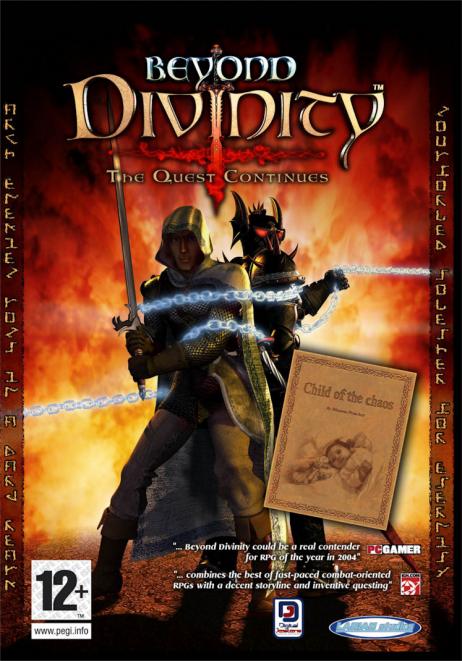Beyond Divinity Review
-
Category: ReviewsHits: 19829

Article Index
Page 1 of 2
Let me begin by offering my curriculum vitae, my credentials, my (what the heck makes him qualified to review a game,) whatever you want to call it. I am a gamer from way back, both PnP and PC. I also love CRPGs. I can't tell you how many hours I've spent on playing them just to find all of the little sub-quests. I've spent enough money on computer games that I could have probably bought a small country. I've got boxes and boxes of rulebooks for so many different RPGs. So many that I can barely remember them all. Let me also make a deal with you. When I review a game I'm going to be straight-up with you. I'll shoot from the hip. I ain't gonna snow you under and make a game sound like something you gotta get if I don't believe that. Okay, so now you know something about me and where I'm coming from let's get to Beyond Divinity.I was looking forward to playing Beyond Divinity, and one thing I can say about it is that it's a long game. The box art is interesting and the screenshots look great. The novella included by game author Rhianna Pratchett is entertaining and serves to whet the appetite for the game to come.
Beyond Divinity is one of those action/RPG hybrids. A genre that has been popularized by Diablo and Diablo 2 (arguably the best of the genre), and the interestingly named Divine Divinity. Some of the features include real time 3D characters, a party combat system, and a (next generation character development system.) This is in addition to over 140 monster and NPC classes and over 300 equipment classes. The dialog is well written and appropriately tongue-in-cheek and the voice acting is over-the-top in a cheesy high fantasy style. The music is top notch. The levels are pretty huge and the fighting fast and furious. These are all good things, so what's the problem, right?
Well. now that you mention it. The game is a little buggy out of the box and suffers from some minor stability, awkward interface, and game balance issues. There is also no way to set the difficulty on-the-fly. Most of these have been fixed in the patch, so I would recommend downloading and installing that before play. Other than that, the game is hard. Really hard. So hard that you'll want to save now and save often. Dying is pretty easy in the game, considering all of the traps and myriad of powerful enemies that you'll face throughout the game. The learning curve isn't too steep, as the gameplay is fairly basic. The storyline is pretty basic. The premise is the same as the movie The Defiant Ones: Two characters who hate each other are forced to work together. The player's character is a soldier for light and goodness, but has been bound to a Death Knight, a servant of darkness and chaos. They may not like each other, as evidenced by some of the Death Knight's dialog throughout the game, but they have to work together to escape and to free themselves from each other.
The character creation tools are fairly standard; you can pick the face from a predetermined set, hair color, sex and name. A unique aspect of the character creation is that the player can select a child's body, which gives an interesting visual when decked out in full armor and carrying a huge weapon. There are three different skill trees to chose from, magic user, warrior, and survivalist (thief). The player can define these skill sets for both the hero and the Death Knight. One of the most original features is the skill creation tool. As a character gains level, they can spend skill points in either improving an already existing skill or in creating an entirely new one. The potential for customization is almost unlimited. Let's get down to the nitty-gritty why don't we.
The gameplay is a mixed bag of both good and not so good. The basic interface is clean, if uninspired. One of the quirks of the game is the ability to use only two of your skills at any one time, since there are no quick slots. Your primary and secondary skills are keyed to your two mouse buttons, and movement is a simple point and click system. The interactivity with objects is second to none, which is both a strength and a weakness of the game as you'll find yourself searching through every container in the game looking for the one item necessary to complete a quest. The PC can interact with objects in interesting ways, such as throwing objects across the room, or using inventory items on world objects for certain results. If you have a bottle in your inventory, try placing it over a beer keg, and you suddenly have a full bottle of beer which you can either drink or sell to a merchant. As mentioned earlier, the world is huge, and the levels are very large. Unfortunately, the game is not as deep as it could have been. The NPCs and monsters are predetermined as to whether you can attack them or not, so the majority of roleplay decisions are made through dialog choices. Although some of the dialog is funny, I found that it didn't really have that big of an effect on gameplay, and that if you made a (wrong) choice that you could go back and correct it by selecting another of the multiple choice options. Character interaction is limited to those NPCs and merchants that the game has predetermined as talking characters. There is a sub quest system in place, but it's pretty conventional. An NPC will ask you to do something, or fetch something. You do it. The NPC will reward you for it.


